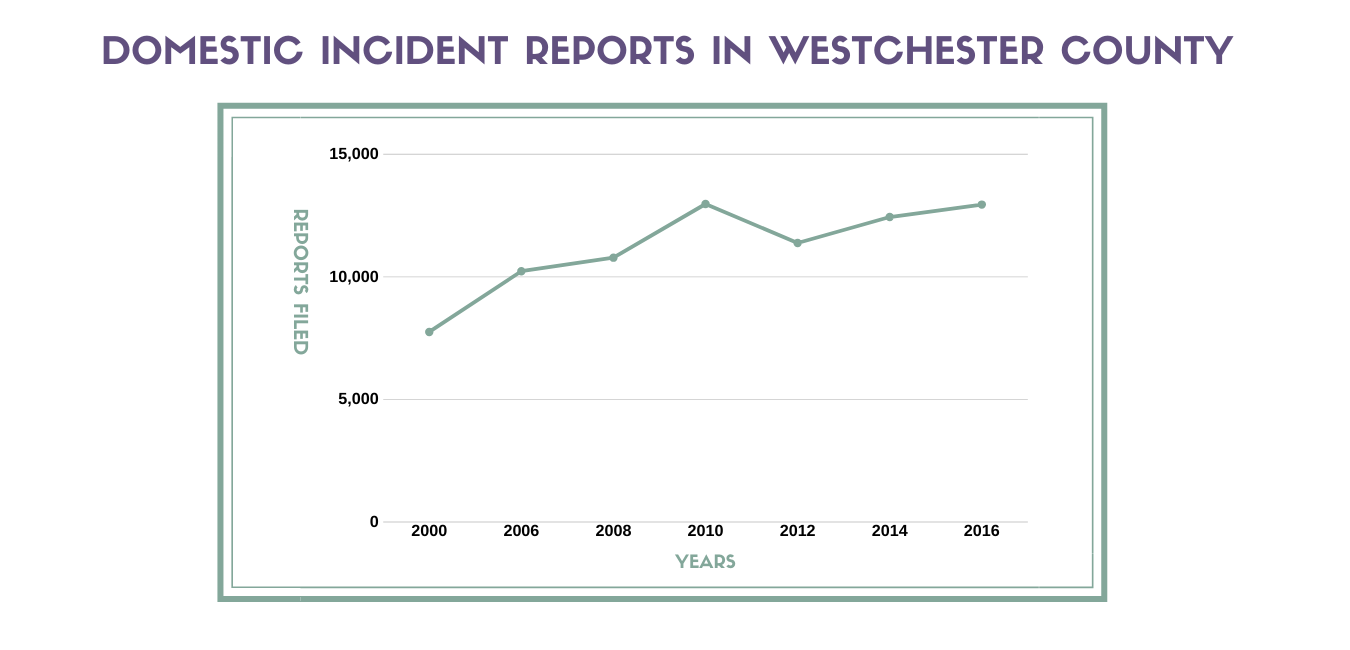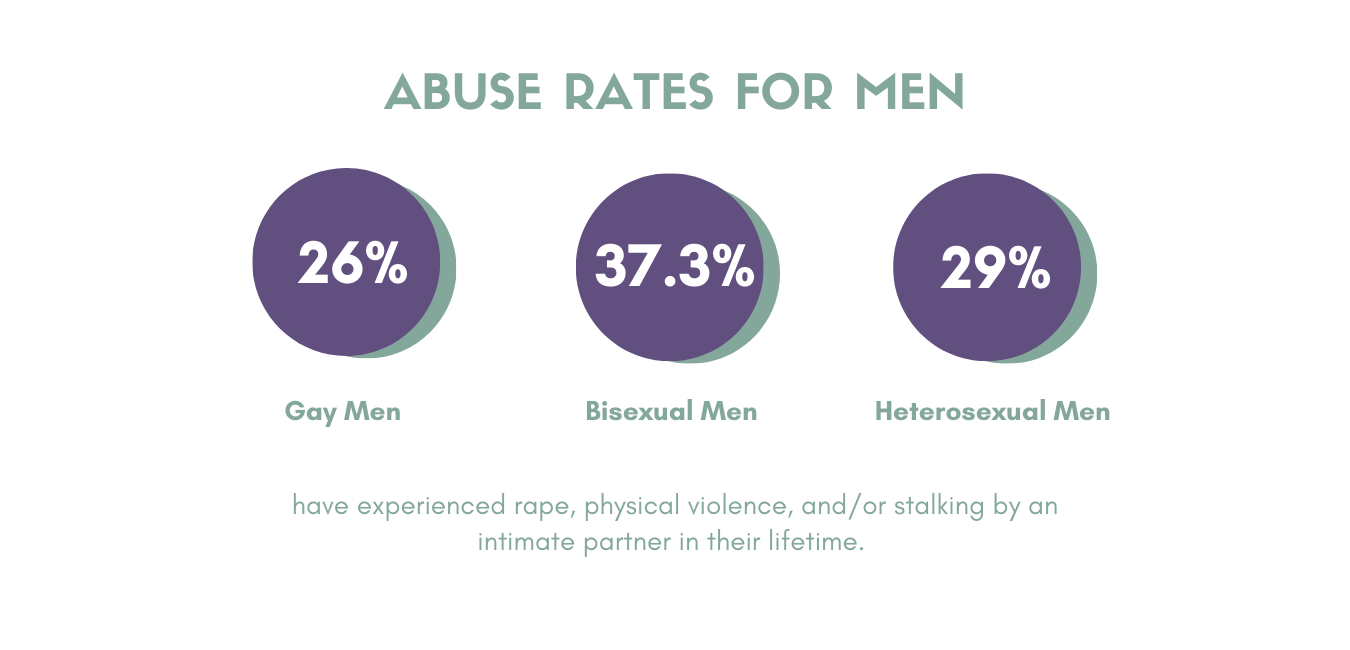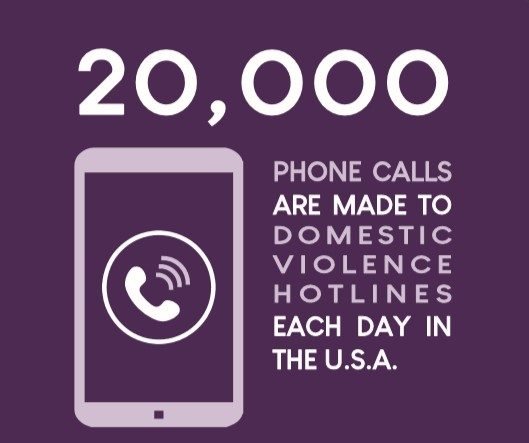Domestic Violence Statistics
The NYS Domestic Incident Report (DIR) is a form that police must complete every time they respond to a domestic incident, whether or not an arrest is made. Here are the number of domestic violence incident reports filed with police departments in Westchester County:

Yet, many victims never report the crime.
Domestic Violence
-
- On average, nearly 20 people per minute are physically abused by an intimate partner in the United States (National Center for Injury & Prevention Control, 2010).
- 1 in 4 women and 1 in 9 men experience severe intimate partner physical violence, intimate partner contact sexual violence, and/or intimate partner stalking (U.S. Department of Justice, Bureau of Justice Statistics, 2014).
- On a typical day, there are more than 20,000 phone calls placed to domestic violence hotlines nationwide ( The National Coalition Against Domestic Violence).
- Intimate partner violence accounts for 15% of all violent crime (U.S. Department of Justice, Bureau of Justice Statistics, 2014).
Disproportionate Impact on Women
While anyone can be a victim of domestic violence, there is a disproportionate impact on women and girls.
-
- Women are 84% of spouse abuse victims and 86% of victims abused by other intimate partners (U.S. Department of Justice, Bureau of Justice Statistics, 2008).
- Women experience two million injuries from intimate partner violence each year (Centers for Disease Control and Prevention, 2008).
- On average more than 3 women a day are murdered by their husbands or boyfriends in the United States (U.S. Department of Justice, Bureau of Justice Statistics, 2007).
- American Indian and Alaska Native women experience the highest rates of intimate partner violence (U.S. Department of Justice, Bureau of Justice Statistics, 2007).
- Women of all ages are at risk for domestic and sexual violence. Those age 20 to 24 are at the greatest risk of experiencing nonfatal intimate partner violence. (U.S. Department of Justice, Bureau of Justice Statistics, 2007)
- Every month, an average of 52 women are shot and killed by an intimate partner ( Federal Bureau of Investigation, Uniform Crime Reporting Program: Supplementary Homicide Reports (SHR), 2013-2017).
Domestic Violence and Men
- Nearly 1 in 10 men in the United States has experienced rape, physical violence, and/or stalking by an intimate partner (Center for Disease Control and Prevention, 2010).
- 48.8% of men have experienced at least one psychologically aggressive behavior (being kept track of by demanding to know his whereabouts, insulted or humiliated, or felt threatened by partner’s actions) by an intimate partner in their lifetime. (Center for Disease Control and Prevention, 2010)
- 1 in 20 (5%) of male murder victims are killed by intimate partners (Bridges, F.S., Tatum, K. M., & Kunselman, J.C., 2008).
Domestic Violence and LGBTQ+


Teen Dating Violence
- 1 in 3 high school students nationwide will experience abuse from a dating partner before graduating.
- Girls and young women between the ages of 16 and 24 experience the highest rate of intimate partner violence, almost triple the national average.
- Of adult men who experience partner abuse, 15% of them report that they first experienced some form of partner violence between 11 and 17 years of age. (Center for Disease Control and Prevention, 2012). The Urban Institute reports significantly higher rates of dating violence among LGBTQ+ youth than among non-LGBTQ+ youth.
- Only 33% of teenage dating abuse victims ever told anyone about it. 81% of parents believe that teen dating violence is not an issue.
Domestic Violence and Children
-
- 1 in 15 children are exposed to intimate partner violence each year, and 90% of these children are eyewitnesses to this violence (U.S. Department of Justice, 2011).
- A study of low-income pre-schoolers finds that children who have been exposed to family violence suffer symptoms of post-traumatic stress disorder, such as bed-wetting or nightmares, and are at greater risk than their peers of having allergies, asthma, gastrointestinal problems, headaches and flu (Graham-Bermann and Seng, 2005).
- Children who experience childhood trauma, including witnessing incidents of domestic violence, are at a greater risk of having serious adult health problems including tobacco use, substance abuse, obesity, cancer, heart disease, depression and a higher risk for unintended pregnancy (Anda, Block and Felitti, 2003).
Domestic Violence and Multicultural Victims

These rates are 30% to 50% higher than those experienced by Hispanic, White non-Hispanic, Asian or Pacific non-Hispanic women.

These rates are nearly twice the rate experienced by Hispanic and White non-Hispanic men.
Domestic Violence and Health
-
- Women who have experienced domestic violence are 80% more likely to have a stroke, 70% more likely to have heart disease, 60% more likely to have asthma and 70% more likely to drink heavily than women who have not experienced intimate partner violence (Centers for Disease Control and Prevention, 2008).
- Women abused by their intimate partners are more vulnerable to contracting HIV or other STI’s due to forced intercourse or prolonged exposure to stress (World Health Organization, 2013).
- Pregnant women are 60.6% more likely to be beaten than non-pregnant women. Violence is cited as a pregnancy complication more often than diabetes, hypertension or any other serious complication (Midwifery Today 19, 1998).
Financial Impact of Domestic Violence
- Victims of intimate partner violence lost almost 8 million days of paid work – the equivalent of more than 32,000 fulltime jobs (Centers for Disease Control and Prevention, 2003).
- The cost of intimate partner violence exceeds $5.8 billion each year, $4.1 billion of which is for direct medical and mental health services (Centers for Disease Control and Prevention, 2003). In today’s dollars, it equates to approximately $8.3 billion each year.










